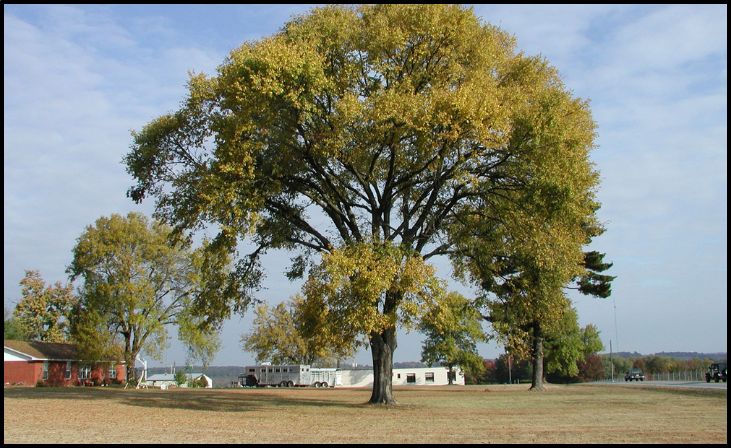America is home to an incredible variety of trees that grace its landscapes with beauty, shade, and ecological benefits. From towering giants to vibrant seasonal displays, these trees capture the essence of the diverse American environment. Here are eight of the most beautiful trees that grow in the United States, each with its own unique charm and appeal.
1. The Magnificent Oak

The oak tree is an iconic symbol of strength and endurance. With its expansive branches and dense foliage, it provides ample shade and a haven for wildlife. Oak trees are found throughout the United States, from the Eastern seaboard to the Midwest. They are known for their longevity, often living for several hundred years. The oak’s acorns are a crucial food source for many animals, including squirrels, deer, and various bird species. In the fall, oak trees turn brilliant shades of red, orange, and yellow, adding a spectacular burst of color to the landscape.
2. The Elegant Magnolia
Magnolia trees are celebrated for their large, fragrant flowers and glossy green leaves. Native to the southeastern United States, magnolias thrive in warm, humid climates. Their blossoms, which range from creamy white to deep pink, are among the most beautiful of any tree. Magnolias are often used in landscaping for their aesthetic appeal and their ability to attract pollinators like bees and butterflies. Some species, like the Southern Magnolia (Magnolia grandiflora), can grow quite large, becoming majestic centerpieces in gardens and parks.
3. The Towering Redwood
Redwood trees, particularly the Coast Redwood (Sequoia sempervirens), are among the tallest trees in the world. Found primarily along the coast of Northern California, these giants can reach heights of over 300 feet. Redwood forests create awe-inspiring landscapes, with their immense trunks and lush understory of ferns and other vegetation. These trees are not only beautiful but also vital to the ecosystem, providing habitat for countless species and playing a crucial role in carbon sequestration. Walking through a redwood forest is a humbling experience, offering a glimpse into the grandeur of nature.
4. The Resilient American Elm

Once a common sight in towns and cities across America, the American Elm (Ulmus americana) was devastated by Dutch elm disease in the mid-20th century. However, thanks to conservation efforts and disease-resistant cultivars, this beautiful tree is making a comeback. American Elms are known for their graceful, vase-shaped canopies and their ability to thrive in urban environments. They provide excellent shade and are an important part of America’s natural heritage. In the spring, their branches are adorned with small, delicate flowers that add a subtle beauty to their stately form.
5. The Vibrant Sugar Maple
The Sugar Maple (Acer saccharum) is famed for its stunning fall foliage, which transforms into a brilliant display of reds, oranges, and yellows. This tree is native to the northeastern United States and Canada, where it thrives in the cool, temperate climate. Aside from its beauty, the Sugar Maple is economically important for its sap, which is harvested to produce maple syrup. The dense, hardwood is also valued for furniture and flooring. Sugar Maples are a staple of autumn landscapes, drawing visitors to admire their vibrant colors and contributing to the region’s tourism industry.
6. The Unique Joshua Tree
The Joshua Tree (Yucca brevifolia) is a striking and unusual tree native to the deserts of the southwestern United States. Its twisted, spiky branches and distinct silhouette make it an iconic symbol of the Mojave Desert. Joshua Trees are adapted to survive in harsh, arid conditions and can live for hundreds of years. They are an essential part of the desert ecosystem, providing habitat and food for various animals. The Joshua Tree’s unique appearance and resilience have made it a subject of fascination and inspiration, attracting artists, photographers, and nature enthusiasts to its rugged habitat.
7. The Enchanting Dogwood
Dogwood trees (Cornus florida) are cherished for their beautiful spring blossoms, which cover the branches in a blanket of white, pink, or red flowers. Native to the eastern United States, Dogwoods thrive in a variety of habitats, from forests to gardens. Their flowers are not only visually stunning but also attract pollinators, making them valuable for local ecosystems. In the fall, Dogwood trees produce bright red berries that provide food for birds and other wildlife. The combination of springtime beauty and autumnal bounty makes the Dogwood a favorite among gardeners and nature lovers alike.
8. The Majestic Bald Cypress

The Bald Cypress (Taxodium distichum) is a distinctive tree found in the swamps and wetlands of the southeastern United States. Known for its “knees” – woody projections that grow from its roots – the Bald Cypress can thrive in standing water and poor soil conditions. These trees can grow to impressive sizes and live for centuries, with some specimens estimated to be over 1,000 years old. In the fall, their feathery, needle-like leaves turn a warm russet color, creating a picturesque scene. Bald Cypress trees are vital to wetland ecosystems, providing habitat for a variety of wildlife and helping to stabilize the soil.
Each of these trees contributes to the rich tapestry of America’s natural beauty. Whether you’re exploring a dense forest, a desert landscape, or a tranquil garden, the presence of these magnificent trees enhances the experience and reminds us of the incredible diversity of the natural world.
